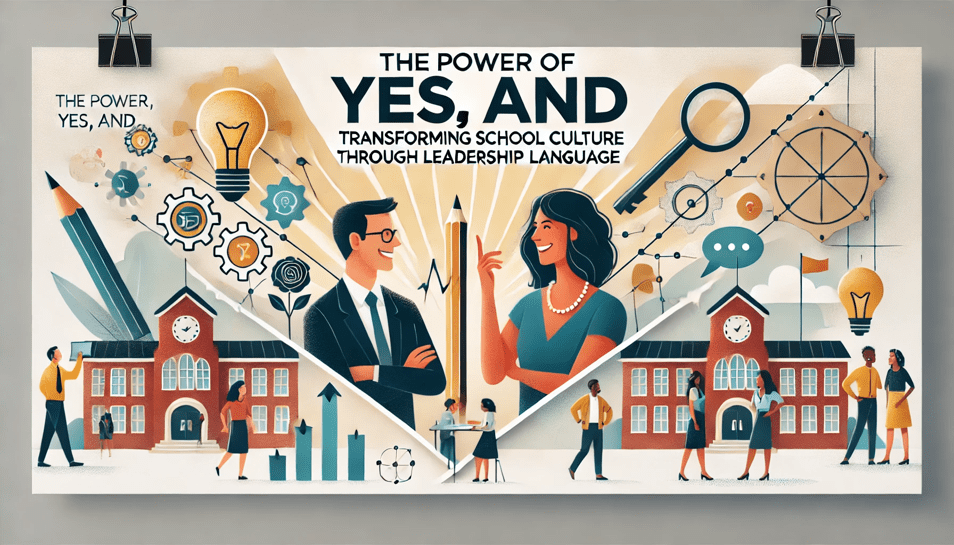From “Yes, But” to “Yes, And”: Transforming School Culture Through Language
February 19, 2025 February 21, 2025
The words we choose as educational leaders shape more than just conversations – they mold school culture, influence teacher innovation, and ultimately impact student success. I want to explore a subtle yet powerful shift in leadership language that can transform your school’s collaborative environment: moving from “yes, but” to “yes, and” thinking.
The Hidden Cost of “Yes, But”
Picture this: A passionate teacher approaches you with an innovative idea for project-based learning in their classroom. Their eyes light up as they describe their vision, but then comes that familiar phrase: “Yes, but what about standardized test preparation?” In that moment, enthusiasm deflates, creativity stalls, and an opportunity for growth begins to wither.
Now consider another scenario that plays out in schools daily: You’re meeting with a teacher about implementing a new literacy strategy that has shown promising results in other classrooms. You share your excitement about the potential impact, but the teacher responds, “Yes, but my students aren’t ready for that level of work. They can barely write a complete sentence.” In this moment, you’re witnessing how “yes, but” thinking doesn’t just stifle innovation – it places artificial limits on student potential. This seemingly small linguistic choice reveals deeper beliefs about student capabilities and becomes a self-fulfilling prophecy. When teachers lead with “yes, but” in discussions about their students, they unconsciously create barriers to achievement before students even have the chance to try.
When we lead with “yes, but,” we unconsciously:
- Signal that limitations outweigh possibilities
- Create a defensive rather than collaborative atmosphere
- Train teachers to self-censor their innovative ideas
- Build invisible walls between administration and faculty
- Lower expectations for student achievement
- Reinforce deficit thinking about student capabilities
- Create self-fulfilling prophecies about student performance
The Power of “Yes, And”
Now imagine those same scenarios transformed by “yes, and” thinking. The principal responds to the teacher’s project-based learning proposal: “Yes, and we could integrate test prep skills naturally within these engaging projects. How might we design this to serve both purposes?” The energy shifts. The conversation moves forward rather than backward. Innovation meets practicality in a dance of possibility.
This positive mindset flows downward. When that principal suggests the new literacy strategy, the teacher now has a model for embracing possibility: “Yes, and we could break this down into smaller steps to help our students build confidence as they master each component.” Notice how the focus shifts from what students can’t do to how we might help them succeed.
The Ripple Effect of “Yes, And” Leadership
When leaders embrace “yes, and” thinking, they create:
- A safe space for teacher innovation
- Validates the original idea while building upon it
- A collaborative problem-solving environment
- A growth mindset culture that permeates all levels
- An atmosphere where creativity thrives
- A pathway for continuous improvement
- Bridges the gap between reality and implementing a vision
When teachers absorb this mindset, they naturally:
- See student potential rather than limitations
- Build scaffolds instead of barriers
- Focus on process rather than just outcomes
- Create opportunities for student growth
- Model optimistic problem-solving for their students
Making the Shift: Practical Steps
The transition from “but” to “and” requires conscious effort at every level. Here’s how to begin:
For Principals:
- Practice active listening when teachers bring new ideas
- Look for ways to connect innovations with existing priorities
- Model the problem-solving mindset you want to see in your teachers
- Celebrate attempts at innovation, not just successes
- Make it safe to experiment and learn from failure
For Teachers:
- Challenge your own assumptions about student capabilities
- Break complex tasks into manageable steps
- Focus on building pathways rather than identifying barriers
- Share success stories of student growth
- Collaborate with colleagues to find creative solutions
Real Impact in Action
A middle school I worked with committed to this language shift throughout their entire system. The principal began by changing their responses to teacher initiatives. Teachers, inspired by this new approach, began viewing student challenges differently. Within one semester:
- Teacher-initiated projects increased
- Cross-departmental collaboration flourished
- Teachers reported higher job satisfaction
- Student participation in challenging tasks improved
- The entire school culture became more positive and solution-focused
Moving Forward Together
As educational leaders, our words create worlds. The simple shift from “yes, but” to “yes, and” can transform our schools from places of limitation to laboratories of possibility. This transformation begins with leadership but must permeate every level of our educational system.
The next time you find yourself about to say “yes, but” – whether you’re a principal speaking to a teacher or listening to a teacher discuss their students – pause and try “yes, and” instead. Watch how the conversation evolves, observe how energy and enthusiasm grow, and notice how solutions naturally emerge from this positive framework.
Remember: Every great educational innovation started with someone saying “yes” to possibility. By adding “and” instead of “but,” we create the conditions for these innovations to flourish at every level of our schools.
Are you ready to make the shift? Your next “yes, and” moment could be the beginning of transformative change in your school community.
